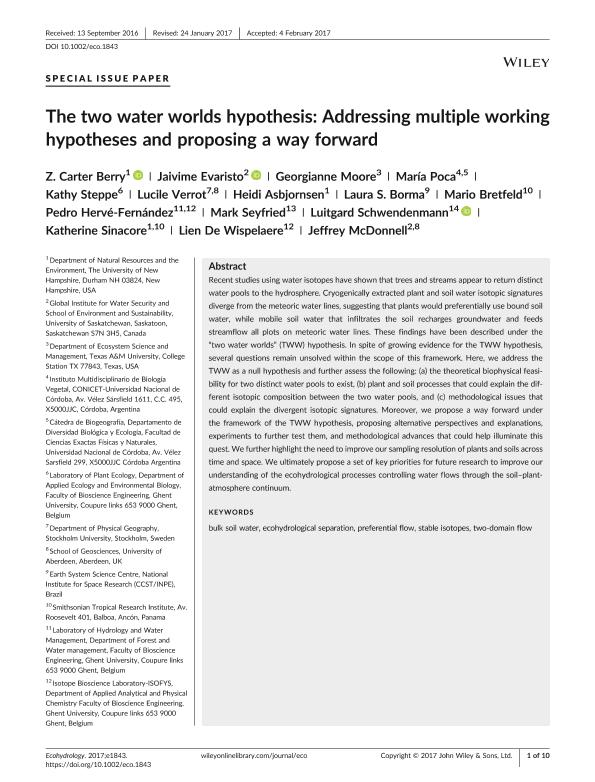Mostrar el registro sencillo del ítem
dc.contributor.author
Berry, Z. Carter
dc.contributor.author
Jaivime, Evaristo
dc.contributor.author
Moore, Georgianne
dc.contributor.author
Poca, María

dc.contributor.author
Steppe, Kathy
dc.contributor.author
Verrot, Lucile
dc.contributor.author
Asbjornsen, Heidi
dc.contributor.author
Borma, Laura S.
dc.contributor.author
Bretfeld, Mario
dc.contributor.author
Hervé-Fernández, Pedro
dc.contributor.author
Seyfried, Mark
dc.contributor.author
Schwendenmann, Luitgard
dc.contributor.author
Sinacore, Katherine
dc.contributor.author
De Wispelaere, Lien
dc.contributor.author
McDonnell, Jeffrey
dc.date.available
2017-07-13T21:30:55Z
dc.date.issued
2017-03
dc.identifier.citation
Berry, Z. Carter; Jaivime, Evaristo; Moore, Georgianne; Poca, María; Steppe, Kathy; et al.; The two water worlds hypothesis: Addressing multiple working hypotheses and proposing a way forward; John Wiley & Sons Inc; Ecohydrology; 3-2017
dc.identifier.issn
1936-0584
dc.identifier.uri
http://hdl.handle.net/11336/20465
dc.description.abstract
Recent studies using water isotopes have shown that trees and streams appear to return distinct water pools to the hydrosphere. Cryogenically extracted plant and soil water isotopic signatures diverge from the meteoric water lines, suggesting that plants would preferentially use bound soil water, while mobile soil water that infiltrates the soil recharges groundwater and feeds streamflow all plots on meteoric water lines. These findings have been described under the ?two water worlds? (TWW) hypothesis. In spite of growing evidence for the TWW hypothesis, several questions remain unsolved within the scope of this framework. Here, we address the TWW as a null hypothesis and further assess the following: (a) the theoretical biophysical feasibility for two distinct water pools to exist, (b) plant and soil processes that could explain the different isotopic composition between the two water pools, and (c) methodological issues that could explain the divergent isotopic signatures. Moreover, we propose a way forward under the framework of the TWW hypothesis, proposing alternative perspectives and explanations, experiments to further test them, and methodological advances that could help illuminate this quest. We further highlight the need to improve our sampling resolution of plants and soils across time and space. We ultimately propose a set of key priorities for future research to improve our understanding of the ecohydrological processes controlling water flows through the soil?plant-atmosphere continuum.
dc.format
application/pdf
dc.language.iso
eng
dc.publisher
John Wiley & Sons Inc

dc.rights
info:eu-repo/semantics/openAccess
dc.rights.uri
https://creativecommons.org/licenses/by-nc-sa/2.5/ar/
dc.subject
Bulk Soil Water
dc.subject
Ecohydrological Separation
dc.subject
Preferential Flow
dc.subject
Stable Isotopes
dc.subject
Two-Domain Flow
dc.subject.classification
Oceanografía, Hidrología, Recursos Hídricos

dc.subject.classification
Ciencias de la Tierra y relacionadas con el Medio Ambiente

dc.subject.classification
CIENCIAS NATURALES Y EXACTAS

dc.title
The two water worlds hypothesis: Addressing multiple working hypotheses and proposing a way forward
dc.type
info:eu-repo/semantics/article
dc.type
info:ar-repo/semantics/artículo
dc.type
info:eu-repo/semantics/publishedVersion
dc.date.updated
2017-07-07T20:06:48Z
dc.identifier.eissn
1936-0592
dc.journal.pais
Estados Unidos

dc.journal.ciudad
New York
dc.description.fil
Fil: Berry, Z. Carter. The University of New
Hampshire. Department of Natural Resources and the Environment; Reino Unido
dc.description.fil
Fil: Jaivime, Evaristo. University of Saskatchewan. Global Institute for Water Security and School of Environment and Sustainability; Canadá
dc.description.fil
Fil: Moore, Georgianne. Texas A&M University. Department of Ecosystem Science and Management; Estados Unidos
dc.description.fil
Fil: Poca, María. Consejo Nacional de Investigaciones Científicas y Técnicas. Centro Científico Tecnológico Conicet - Córdoba. Instituto Multidisciplinario de Biología Vegetal. Universidad Nacional de Córdoba. Facultad de Ciencias Exactas Físicas y Naturales. Instituto Multidisciplinario de Biología Vegetal; Argentina
dc.description.fil
Fil: Steppe, Kathy. Ghent University. Faculty of Bioscience Engineering. Department of Applied Ecology and Environmental Biology. Laboratory of Plant Ecology; Bélgica
dc.description.fil
Fil: Verrot, Lucile. Stockholm University. Department of Physical Geography; Suecia. University of Aberdeen. School of Geosciences; Reino Unido
dc.description.fil
Fil: Asbjornsen, Heidi. The University of New
Hampshire. Department of Natural Resources and the Environment; Reino Unido
dc.description.fil
Fil: Borma, Laura S.. National Institute for Space Research. Earth System Science Centre; Reino Unido
dc.description.fil
Fil: Bretfeld, Mario. Smithsonian Tropical Research Institute; Panamá
dc.description.fil
Fil: Hervé-Fernández, Pedro. Ghent University. Faculty of Bioscience
Engineering. Department of Forest and
Water management. Laboratory of Hydrology and Water Management; Bélgica. Ghent University. Faculty of Bioscience Engineering. Department of Applied Analytical and Physical Chemistry. Isotope Bioscience Laboratory; Bélgica
dc.description.fil
Fil: Seyfried, Mark. USDA ARS Northwest Watershed Research
Center; Estados Unidos
dc.description.fil
Fil: Schwendenmann, Luitgard. The University Of Auckland; Nueva Zelanda. The University of
Auckland. School of Environment; Nueva Zelanda
dc.description.fil
Fil: Sinacore, Katherine. The University of New Hampshire. Department of Natural Resources and the Environment; Reino Unido. Smithsonian Tropical Research Institute; Panamá
dc.description.fil
Fil: De Wispelaere, Lien. Ghent University. Faculty of Bioscience Engineering. Department of Applied Analytical and Physical Chemistry. Isotope Bioscience Laboratory; Bélgica
dc.description.fil
Fil: McDonnell, Jeffrey. University of Saskatchewan. Global Institute for Water Security and School of Environment and Sustainability; Canadá. University of Aberdeen. School of Geosciences; Reino Unido
dc.journal.title
Ecohydrology

dc.relation.alternativeid
info:eu-repo/semantics/altIdentifier/doi/http://dx.doi.org/10.1002/eco.1843
dc.relation.alternativeid
info:eu-repo/semantics/altIdentifier/url/http://onlinelibrary.wiley.com/doi/10.1002/eco.1843/full
Archivos asociados
